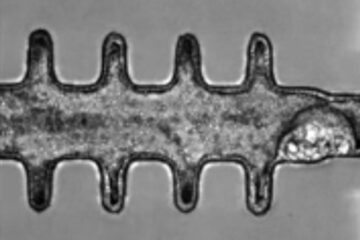Skeleton Of Sun's Atmosphere Reveals Its True Nature

Scientists have now made a major breakthrough in understanding this complexity by studying the ‘skeleton’ of the magnetic field. A team of scientists from St Andrew’s University will present the results on Monday 16 April at the Royal Astronomical Society National Astronomy Meeting in Preston. “It is the Sun's magnetic field that dominates the behaviour of the corona and determines its structure”, said team member Andrew Haynes, “and our work is a key step forward in understanding its structure”.
Until now the complexity of the magnetic field has baffled solar scientists. Professor Eric Priest first proposed the concept of the solar skeleton in 1996. It consists of the key elements on which the complex shape of the magnetic field is built. “We realised”, added Dr Clare Parnell, “that by constructing the skeleton of the field, we could unravel this complexity and hopefully determine how the corona is heated”.
Dr Parnell and colleagues have managed to develop a computer experiment, which simulates the complex structure of the corona and have found that the coronal heating is focused in specific parts of the skeleton. “In future”, she added, “we should be able to compare this type of analysis with dramatic new observations from the recently launched Hinode spacecraft and thereby really nail down the heating mechanism”.
The work of the St Andrew’s team indicates that the solar skeleton changes continually and has a much richer structure than anyone imagined. Their work is a building block in astronomers’ efforts to better understand events such as the solar flares and coronal mass ejections that eject billions of tonnes of matter into space.
Media Contact
All latest news from the category: Physics and Astronomy
This area deals with the fundamental laws and building blocks of nature and how they interact, the properties and the behavior of matter, and research into space and time and their structures.
innovations-report provides in-depth reports and articles on subjects such as astrophysics, laser technologies, nuclear, quantum, particle and solid-state physics, nanotechnologies, planetary research and findings (Mars, Venus) and developments related to the Hubble Telescope.
Newest articles

Solving the riddle of the sphingolipids in coronary artery disease
Weill Cornell Medicine investigators have uncovered a way to unleash in blood vessels the protective effects of a type of fat-related molecule known as a sphingolipid, suggesting a promising new…

Rocks with the oldest evidence yet of Earth’s magnetic field
The 3.7 billion-year-old rocks may extend the magnetic field’s age by 200 million years. Geologists at MIT and Oxford University have uncovered ancient rocks in Greenland that bear the oldest…

Mini-colons revolutionize colorectal cancer research
As our battle against cancer rages on, the quest for more sophisticated and realistic models to study tumor development has never been more critical. Until now, research has relied on…





















